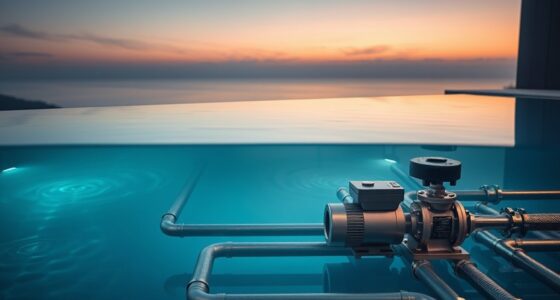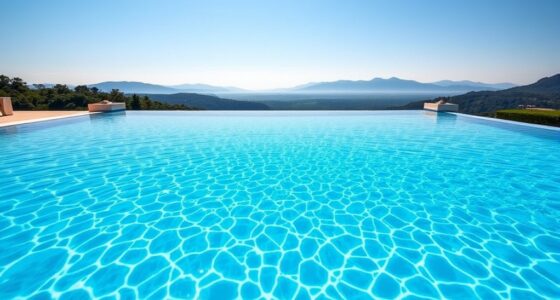To quiet your waterfall and create a peaceful outdoor space, use natural barriers like dense plants and earth mounds to absorb sound, and position water features strategically to mask noise. Incorporate soundproofing materials, soft textiles, and barriers to dampen reflections and muffling unwanted sounds. Combining these acoustic tricks can transform your area into a calming retreat. Keep exploring further tips to make your outdoor sanctuary even more tranquil.
Key Takeaways
- Use dense vegetation and natural barriers around the waterfall to absorb and block noise transmission.
- Incorporate water features with gentle, consistent sounds placed strategically to mask loud water noise.
- Apply soundproofing materials like acoustic panels or thick insulation nearby to contain or reduce sound escape.
- Re-arrange surrounding structures or furniture to deflect or absorb sound waves, minimizing disturbance.
- Create a layered landscape with berms and soft landscaping to disrupt sound paths and enhance noise reduction.
Understanding How Sound Propagates
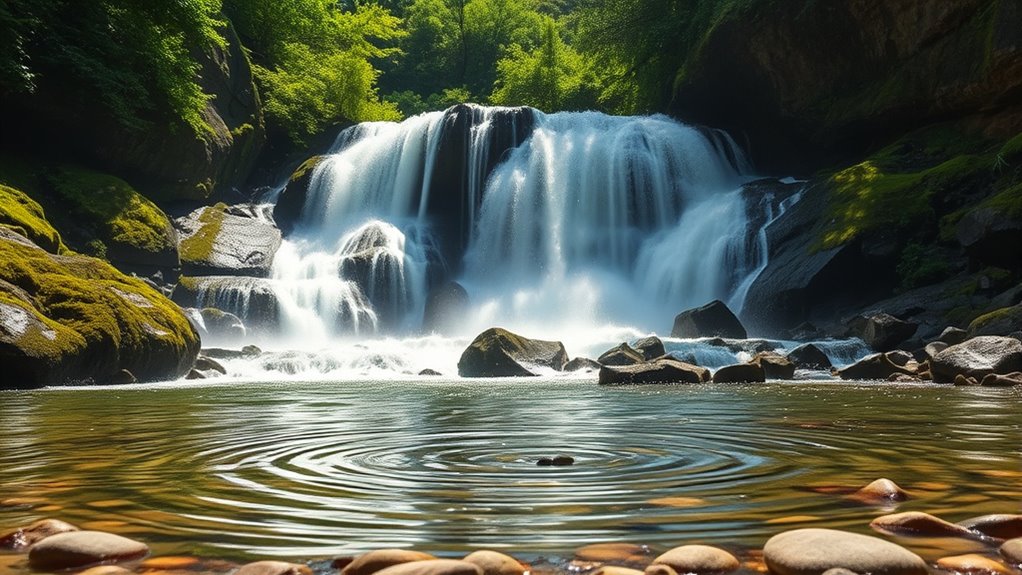
Sound travels through the air by creating vibrations that move molecules from one to the next. When you make a sound, like a whisper or a splash, it generates ripples in the surrounding air. These ripples are vibrations that transfer energy through the molecules, pushing and pulling them in a wave-like pattern. As molecules vibrate, they pass the energy along to neighboring molecules, spreading the sound outward. The speed and clarity of sound depend on factors like the medium’s density and temperature. In air, sound moves at about 343 meters per second. Understanding this process helps you realize how sound travels, how it can be muffled or amplified, and why certain environments, like a quiet room or an open field, affect what you hear. Additionally, the way sound propagates can be affected by environmental factors, influencing how clearly sound reaches your ears.
The Power of White Noise and Nature Sounds
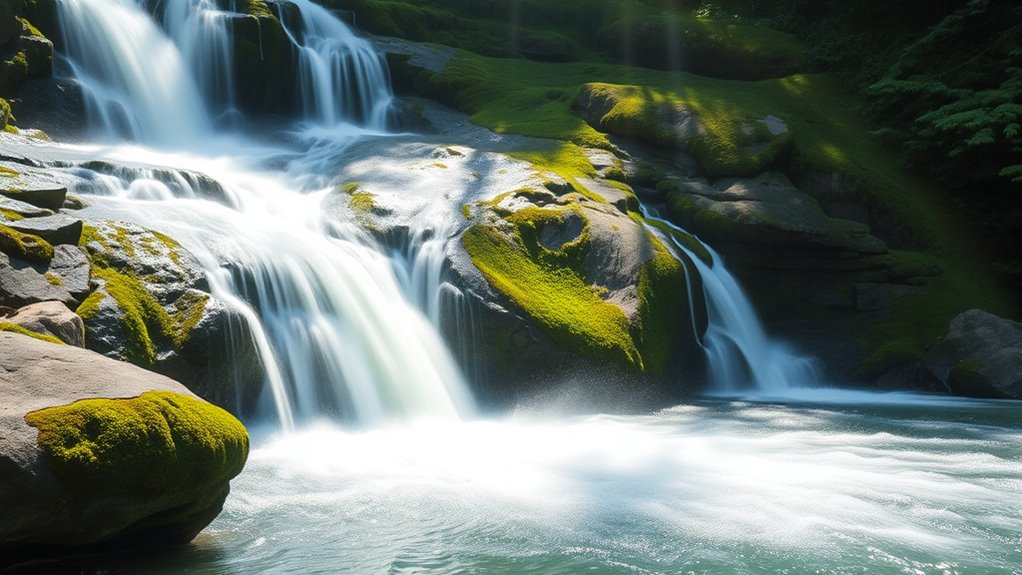
While white noise and nature sounds might seem simple, they hold powerful effects on your mind and body. These sounds mask disruptive noises, creating a calming environment that fosters focus and relaxation. They can also reduce stress by triggering soothing physiological responses. Additionally, white noise and natural sounds help improve sleep by blocking out disturbances and establishing consistent auditory cues. To maximize benefits, consider:
- Using continuous sound machines or apps for consistency.
- Selecting nature sounds that resonate personally, like rain or ocean waves.
- Adjusting volume to a comfortable level that doesn’t overwhelm.
- Incorporating sounds into daily routines to reinforce relaxation habits.
Furthermore, the integration of AI-driven sound customization can enhance individual relaxation experiences by adapting to personal preferences AI applications in learning and entertainment.
Using Sound Barriers to Diminish Waterfall Noise
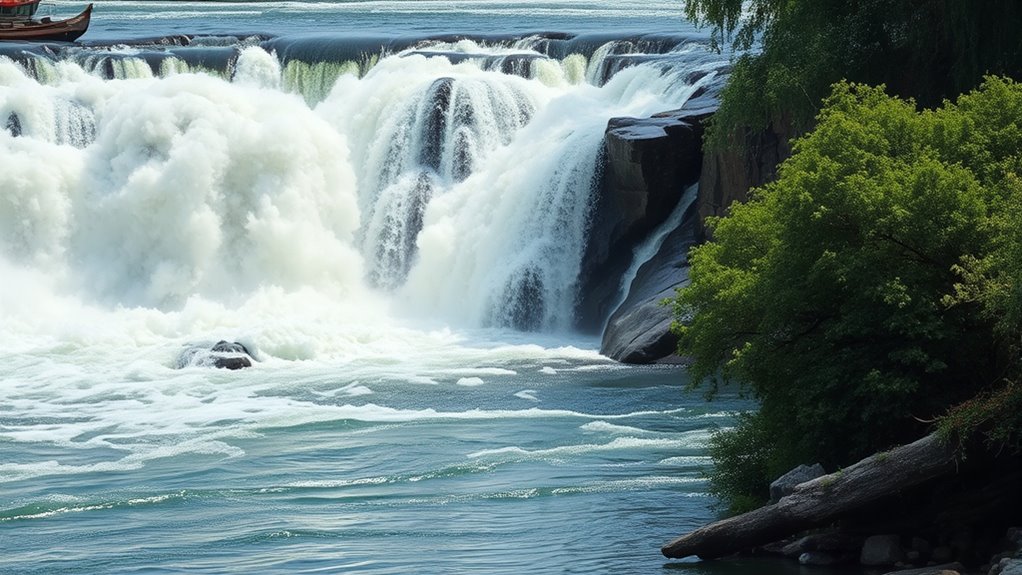
If you want to reduce the overwhelming roar of a waterfall nearby, installing effective sound barriers can make a significant difference. These barriers work by blocking and absorbing sound waves before they reach your space. You can use physical structures like walls, fences, or specially designed acoustic panels placed strategically between the waterfall and your area. Materials such as dense wood, mass-loaded vinyl, or foam absorb sound effectively. Taller and thicker barriers provide better noise reduction, especially if they extend above ear level. Positioning the barriers close to the waterfall maximizes their impact. Remember, combining sound barriers with other techniques, like natural elements or white noise, enhances overall effectiveness. Additionally, understanding environmental considerations ensures your barriers are sustainable and minimally disruptive. With the right barriers, you’ll enjoy a quieter, more peaceful environment despite the waterfall’s powerful presence.
Strategic Placement of Plants and Landscaping
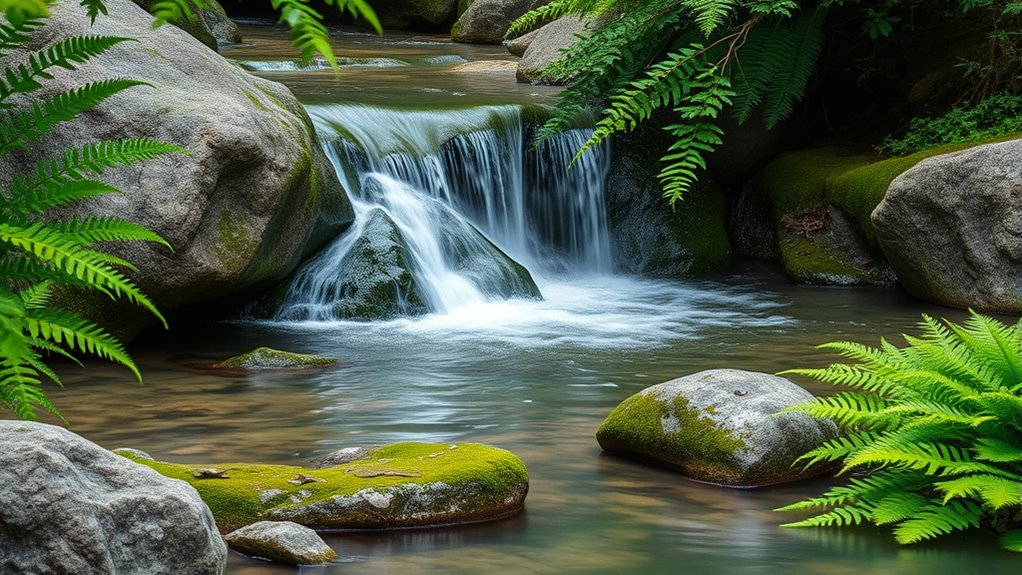
Strategically placing plants and landscaping features can substantially reduce the noise from a nearby waterfall. By choosing the right greenery, you create natural sound barriers that absorb and block sound waves. Tall shrubs and dense bushes work best when positioned directly in front of the waterfall, breaking up sound paths. Incorporate layered plantings—mixing trees, shrubs, and ground covers—to enhance noise reduction. Using landscaping features like berms or mounds can also elevate your plantings, increasing their effectiveness. Additionally, selecting sound-absorbing plant species can further improve the noise mitigation efforts. Consider these key strategies: 1. Plant dense, tall vegetation close to the waterfall. 2. Use layered plantings for maximum sound absorption. 3. Incorporate berms or mounds to add height and depth. 4. Combine hardscape elements with soft landscaping for optimal noise control.
Incorporating Water Features for Sound Masking
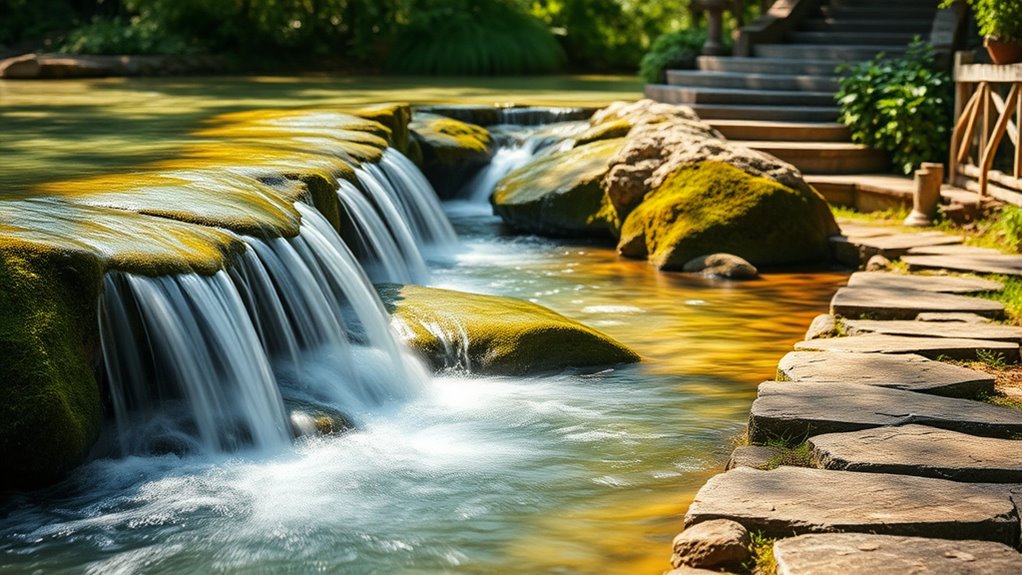
You can effectively mask unwanted noise by strategically placing water features where they can create the most soothing sound. Choose water sounds like gentle streams or soft waterfalls that blend well with your landscape and don’t overpower your space. Positioning these features thoughtfully helps guarantee they provide calming background noise without becoming a distraction. Additionally, selecting water features with sound masking capabilities can enhance the overall tranquility of your outdoor area.
Strategic Placement Techniques
To effectively mask unwanted noise, placing water features thoughtfully within your landscape is essential. Proper placement ensures sound travels efficiently and covers disruptive noises. Consider these strategies:
- Position water features near noisy areas, like busy streets or neighbors, to create a sound barrier.
- Place features at different heights and distances to distribute sound evenly.
- Use natural barriers, such as shrubs or trees, to direct noise away from quiet zones.
- Place water features where they can be heard from outdoor seating or frequently used spaces, maximizing their masking effect.
- Incorporate sound masking techniques by selecting water features with the right size and flow to optimize noise coverage.
Choosing Soothing Water Sounds
Choosing the right water sounds is essential for creating a calming outdoor environment. You want sounds that mask noise without overwhelming the space, promoting relaxation. Consider gentle streams, soft fountains, or trickling waterfalls that produce consistent, soothing noise. To help you decide, review the options below:
| Water Feature | Sound Character |
|---|---|
| Shallow Fountain | Light, bubbly, calming |
| Cascading Waterfall | Rhythmic, gentle roar |
| Dripping Pebbles | Soft, subtle, localized sound |
Select features that blend naturally with your landscape while providing a peaceful auditory backdrop. The goal is to mask noise pollution and foster tranquility. Choose wisely to create a serene outdoor retreat, enhancing your outdoor living space with sound masking techniques that promote relaxation and privacy.
Employing Portable White Noise Machines

Employing portable white noise machines offers a convenient way to mask disruptive sounds and create a calming environment. You can easily move them around your space, ensuring consistent sound coverage wherever needed. To maximize their effectiveness, consider these tips:
- Choose a device with adjustable volume and tone controls to tailor the sound to your preference.
- Position the machine close to the noise source or your resting area for ideal masking.
- Use timers to prevent constant noise, allowing for periods of silence when desired.
- Opt for machines with a variety of sound options, such as nature sounds or ambient noises, to enhance relaxation.
- Incorporating AI technology into noise machines can improve sound quality and adapt to your environment for a more personalized experience.
Creating a Sound-Dampening Shelter or Structure
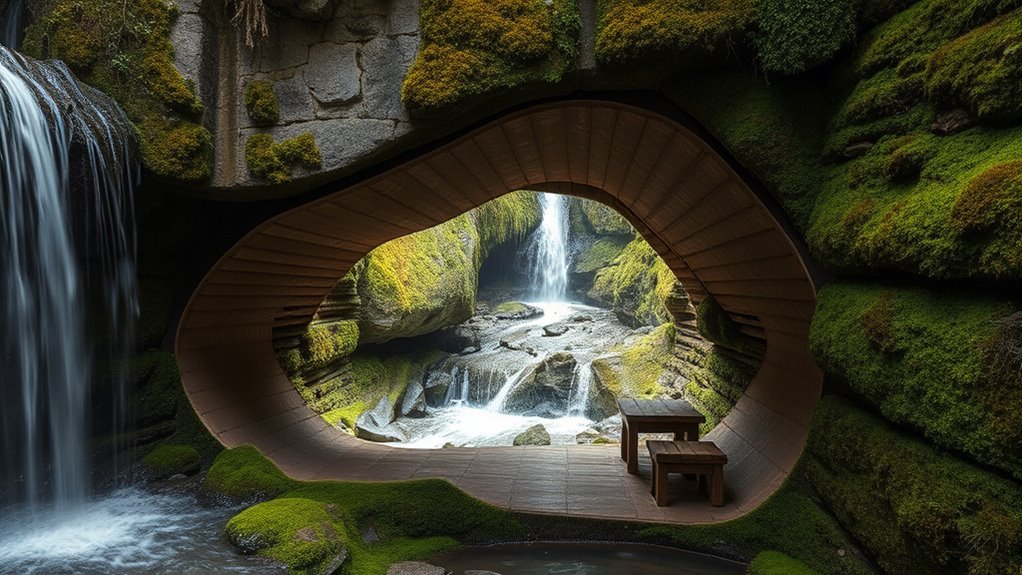
When building a sound-dampening shelter, choosing the right materials is essential; opt for dense, layered options like mass-loaded vinyl or thick insulation. Incorporate structural design techniques such as staggered walls or double layers to reduce sound transmission effectively. By combining smart material choices with thoughtful design, you can create a shelter that greatly diminishes the waterfall noise. Additionally, expert voice actors can provide insights into acoustic treatment and soundproofing techniques for optimal results.
Material Selection Strategies
Selecting the right materials is essential for creating an effective sound-dampening shelter or structure. Your goal is to block and absorb noise efficiently, so choose wisely. First, opt for dense materials like mass-loaded vinyl or thick insulation to reduce sound transmission. Second, incorporate porous substances such as mineral wool or acoustic foam that absorb sound waves. Third, consider layering materials—combining mass and absorption enhances effectiveness. Fourth, avoid materials that resonate or amplify sound, like thin plastics or metals. Additionally, understanding the sound absorption properties of materials helps optimize your design for maximum noise reduction. By carefully selecting these components, you ensure your shelter minimizes noise infiltration and creates a peaceful environment. Remember, the materials’ density, porosity, and layering are key to achieving ideal sound dampening. Precision in material choice directly impacts the tranquility you seek.
Structural Design Techniques
Designing a sound-dampening shelter begins with thoughtful structural choices that enhance noise reduction. You should prioritize mass and thickness, as heavier walls absorb more sound. Incorporate irregular shapes and layered designs to disrupt sound waves. Using barriers like berms or earth mounds can further block noise. Proper placement also matters; position structures away from the waterfall’s direct line of sight. Ventilation openings should be sealed or muffled to prevent sound leaks. Here’s a quick guide:
| Material | Thickness | Purpose |
|---|---|---|
| Concrete | 8-12 inches | Absorbs low-frequency sounds |
| Dense foam | Varies | Dampens high-frequency noise |
| Earth/soil | 2-4 feet thick | Mass and natural insulation |
| Acoustic panels | Customizable | Targeted sound absorption |
| Mass-loaded vinyl | Thin but dense | Additional noise barrier |
Using Soft Textiles and Materials to Absorb Sound

Have you ever noticed how soft textiles and materials can make a room sound calmer? They absorb sound waves, reducing echoes and background noise. To maximize this effect, consider adding:
Soft textiles and materials help create a calmer, quieter room by absorbing sound.
- Thick curtains or drapes over windows to muffle outside noise
- Plush rugs or carpets to dampen footsteps and airborne sounds
- Upholstered furniture like sofas and armchairs to absorb sound energy
- Acoustic wall panels or fabric-covered boards for targeted sound absorption
These elements work together to create a quieter environment by trapping sound waves before they bounce around. Using soft textiles is an easy, effective way to soften the acoustic footprint of your space, making it more peaceful and less chaotic.
Adjusting Your Environment for Optimal Noise Reduction

Building on the use of soft textiles, fine-tuning your environment can further enhance noise reduction. Start by identifying and blocking noise sources, like windows or doors, with weatherstripping or draft stoppers. Rearrange furniture to create barriers that deflect sound away from your space. Use rugs or carpets on hard floors to dampen reflections. Adjust the placement of electronics or appliances that emit constant noise, turning them off or relocating them if possible. Consider positioning your seating or work areas away from noisy windows or walls. Keep doors closed to contain sound within specific areas. By making these adjustments, you minimize sound entry points and create a more serene environment, making it easier to find peace despite outside disturbances.
Practical Tips for Maintaining a Peaceful Space
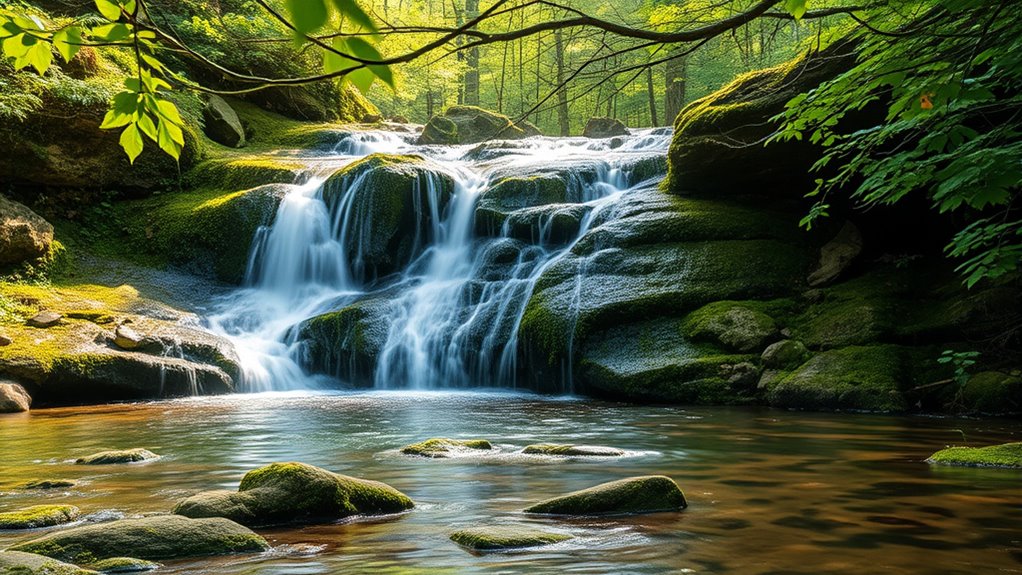
Maintaining a peaceful space requires consistent effort and mindful habits. You need to actively manage your environment and routines to preserve tranquility. Here are four practical tips to help you stay on track:
- Regularly declutter your space to reduce visual noise and stress.
- Set boundaries for noise levels, like limiting loud activities during quiet hours.
- Incorporate calming routines, such as gentle music or breathing exercises, into your daily schedule.
- Use natural elements, like plants or water features, to reinforce a serene atmosphere.
Frequently Asked Questions
Can Indoor Soundproofing Techniques Effectively Block Outdoor Waterfall Noise?
Yes, indoor soundproofing techniques can effectively block outdoor waterfall noise. You can use dense materials like mass-loaded vinyl or thick drywall to absorb sound, install double-glazed windows to reduce noise transmission, and add soft furnishings such as rugs and curtains to dampen sound waves. Sealing gaps around doors and windows also helps prevent noise leaks, making your space noticeably quieter and more peaceful despite the outdoor waterfall.
Are There Specific Plants That Naturally Reduce Sound More Effectively?
Yes, certain plants naturally reduce sound more effectively. You should consider dense, broad-leafed plants like rhododendrons, laurels, and holly, which absorb and block noise better. Tall grasses and shrubs also help create a sound barrier. Planting these around your outdoor space can markedly dampen unwanted noise, making your environment more peaceful. Make sure you place them strategically for maximum coverage and consider their growth habits for long-term noise reduction.
How Long Does It Take for Sound Barriers to Significantly Reduce Noise?
Sound barriers typically take a few weeks to a few months to considerably reduce noise levels, depending on their size, material, and placement. As you install and adjust them, you’ll notice gradual improvements in sound reduction. Keep in mind that ideal effectiveness comes from proper positioning and using high-density materials. Be patient during this period, and you’ll eventually experience a quieter environment that helps you relax and enjoy your space more peacefully.
What Are Cost-Effective Options for Creating a Peaceful Water’s Edge?
You can create a peaceful water’s edge without breaking the bank by adding natural elements like shrubs, tall grasses, and strategically placed rocks, which absorb and deflect sound. Installing affordable windbreaks or fences made from wood or bamboo also helps reduce noise. These cost-effective options transform your space into a tranquil retreat, making peaceful waterside living feel like a reality rather than a distant dream.
Can Outdoor Furniture Help Absorb or Deflect Waterfall Sounds?
Yes, outdoor furniture can help absorb or deflect waterfall sounds. Thick, cushioned pieces like outdoor sofas or chairs with fabric upholstery absorb some noise, reducing the sound’s intensity. Strategically placing furniture around your water feature creates a barrier that deflects sound waves, helping to muffle the waterfall noise. Choose furniture with soft, textured surfaces and arrange it thoughtfully to maximize noise reduction and create a more peaceful outdoor space.
Conclusion
By understanding sound and strategically shaping your environment, you can transform chaos into calm. While waterfalls roar with nature’s power, your mindful choices—plants, barriers, textiles—serve as gentle whispers of peace. It’s a delicate balance, where silence isn’t absence but a curated harmony. Embrace these tricks to craft your peaceful edge, where the relentless cascade becomes a distant hum, and tranquility, a deliberate act of quiet strength amid nature’s wild chorus.



